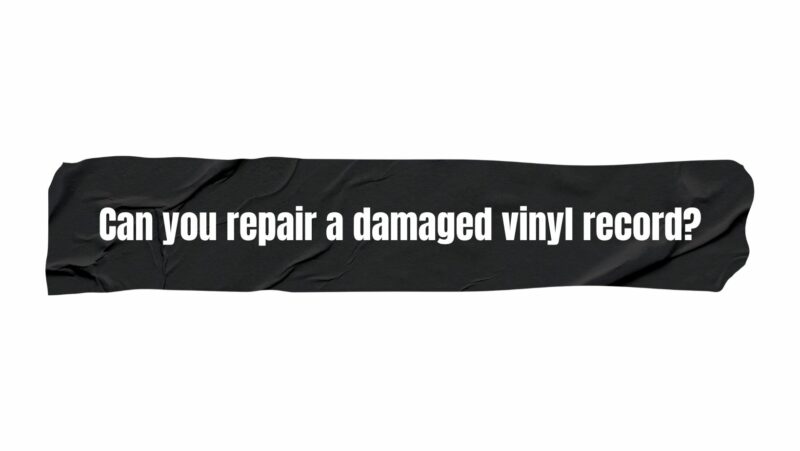In the realm of music enthusiasts and collectors, vinyl records hold a cherished place as relics of the past, evoking nostalgia and authenticity that digital formats often fail to replicate. However, the passage of time can lead to wear and tear, causing these prized possessions to become damaged. The question arises: Can you repair a damaged vinyl record? This article delves into the world of vinyl record restoration, exploring the techniques and considerations involved in breathing new life into scratched, warped, and cracked records.
Understanding Vinyl Records: Before delving into the restoration process, it’s crucial to understand the anatomy of a vinyl record. A vinyl record consists of a circular disc made from polyvinyl chloride (PVC), with grooves that carry the audio information. The stylus of a turntable traces these grooves, producing sound. Any damage to these grooves can adversely affect the sound quality.
Common Types of Damage: Vinyl records can suffer from various types of damage, ranging from minor to severe. Scratches, one of the most common issues, can result from mishandling, improper storage, or dust particles on the surface. Warping occurs due to exposure to heat or pressure, causing the record to lose its flat shape. Cracks, while less common, can drastically impact playback quality. Additionally, groove wear, caused by repeated stylus contact, leads to a gradual decline in audio fidelity.
Assessment of Damage: Before attempting any restoration, a thorough assessment of the damage is essential. Minor surface scratches may not necessarily warrant extensive intervention, while deep scratches or cracks demand more careful attention. Professionals often employ specialized equipment, such as magnifying lenses and light sources, to inspect records for hidden imperfections.
DIY vs. Professional Restoration: The decision to repair a damaged vinyl record yourself or seek professional help depends on factors like your comfort level with DIY techniques and the extent of the damage. For minor scratches, there are DIY kits available that include solutions for filling and smoothing out scratches. However, for intricate repairs and severe damage, seeking professional restoration services is advisable. Experts possess the necessary equipment, experience, and techniques to handle delicate restoration tasks.
DIY Techniques:
- Cleaning: Regardless of the extent of damage, a thorough cleaning is the first step. Use a soft brush or microfiber cloth to remove dust and debris. Cleaning solutions specially formulated for vinyl records can be used, applied gently with a soft cloth.
- Scratch Repair: For minor scratches, various DIY kits offer solutions like liquid compounds or pastes designed to fill in scratches. These solutions are applied, allowed to dry, and then gently polished to create a smoother surface.
- Heat Flattening: Warped records can be treated with heat flattening techniques. Placing the record between two sheets of glass and exposing it to controlled heat can help restore its flat shape. However, this technique requires careful monitoring to prevent overheating and further damage.
Professional Restoration Techniques:
- Vinyl Resurfacing Machines: Professional restorers often use vinyl resurfacing machines that carefully remove a thin layer of vinyl from the surface, effectively eliminating scratches and imperfections. This technique requires expertise to ensure that excessive material isn’t removed, impacting sound quality.
- Microscopic Groove Repair: Advanced techniques involve using microscopes to assess and repair individual grooves. This level of precision is essential for maintaining the integrity of the audio information encoded on the record.
- Ultrasonic Cleaning: Ultrasonic cleaning involves using high-frequency sound waves to remove dirt and contaminants from the grooves without causing additional damage. This technique is especially effective for deep cleaning and restoration.
Preservation and Preventive Measures: Prevention is the best cure, and this adage holds true for vinyl records. Proper storage, including keeping records upright, away from direct sunlight and heat sources, can significantly extend their lifespan. Using inner and outer sleeves made from archival-quality materials can prevent scratches and dust accumulation. Regular cleaning with a carbon-fiber brush can also help maintain records’ condition.
Conclusion: While the wear and tear that accompanies the passage of time can leave vinyl records damaged, the world of restoration offers a glimmer of hope. Whether you’re a dedicated collector or an audiophile, the decision to repair a damaged vinyl record involves careful consideration of the type and extent of damage, available techniques, and the value placed on preserving the record’s historical and auditory significance. With a plethora of DIY solutions and professional restoration services at your disposal, damaged vinyl records can indeed find a second chance at life, allowing the timeless melodies etched in their grooves to resonate once again.


